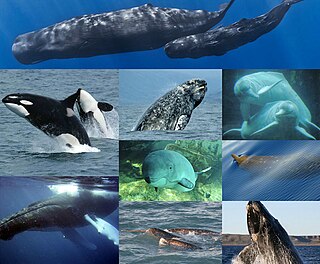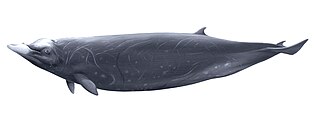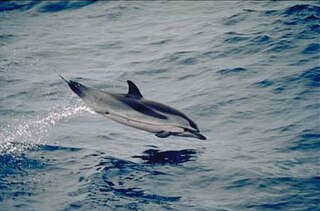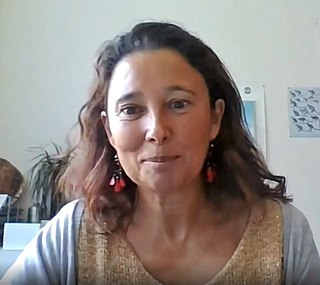
Cetacea is an infraorder of aquatic mammals belonging to the order Artiodactyla that includes whales, dolphins, and porpoises. Key characteristics are their fully aquatic lifestyle, streamlined body shape, often large size and exclusively carnivorous diet. They propel themselves through the water with powerful up-and-down movement of their tail which ends in a paddle-like fluke, using their flipper-shaped forelimbs to maneuver.

Marine mammals are mammals that rely on marine (saltwater) ecosystems for their existence. They include animals such as cetaceans, pinnipeds, sirenians, sea otters and polar bears. They are an informal group, unified only by their reliance on marine environments for feeding and survival.

Hubbs' beaked whale was initially thought to be an Andrews' beaked whale when discovered by ichthyologist Carl Hubbs; however, it was named in his honor when it was discovered to be a new species. This species has the typical dentition found in the genus, but its main outstanding features are a white "cap" on the head and very extensive scarring. The species is known from 31 strandings, a few at-sea sightings, and observations of two stranded whales that were kept in captivity for 16–25 days.

The short-finned pilot whale is one of the two species of cetaceans in the genus Globicephala, which it shares with the long-finned pilot whale. It is part of the oceanic dolphin family (Delphinidae).

The melon-headed whale, also known less commonly as the electra dolphin, little killer whale, or many-toothed blackfish, is a toothed whale of the oceanic dolphin family (Delphinidae). The common name is derived from the head shape. Melon-headed whales are widely distributed throughout deep tropical and subtropical waters worldwide, but they are rarely encountered at sea. They are found near shore mostly around oceanic islands, such as Hawaii, French Polynesia, and the Philippines.

The striped dolphin is an extensively researched dolphin found in temperate and tropical waters of all the world's oceans. It is a member of the oceanic dolphin family, Delphinidae.

Reflection seismology is a method of exploration geophysics that uses the principles of seismology to estimate the properties of the Earth's subsurface from reflected seismic waves. The method requires a controlled seismic source of energy, such as dynamite or Tovex blast, a specialized air gun or a seismic vibrator. Reflection seismology is similar to sonar and echolocation.

Cetacean bycatch is the accidental capture of non-target cetacean species such as dolphins, porpoises, and whales by fisheries. Bycatch can be caused by entanglement in fishing nets and lines, or direct capture by hooks or in trawl nets.

The Tethys Research Institute is a non-profit research organisation founded in 1986 to support marine conservation through science and public awareness and by participating in the international conservation process. Tethys' activities are mainly carried out in the Mediterranean Sea, although research programmes have been conducted also in the Black Sea, the North Atlantic Ocean, the Caribbean, the Red Sea and Antarctica. The results of these activities have been presented in scientific publications as well as in meetings, workshops and conferences.
The Bottlenose Dolphin Research Institute (BDRI) is a research and educational centre dedicated to the understanding and conservation of cetaceans and the marine environment in which they live. The Institute's BDRI center was founded by the biologist Bruno Díaz López in Sardinia, Italy in 2005. In 2014, the BDRI opened a new facility in Galicia, Spain.

The Agreement on the Conservation of Cetaceans of the Black Sea, Mediterranean Sea and contiguous Atlantic Area, or ACCOBAMS, is a regional international treaty that binds its States Parties on the conservation of Cetacea in their territories. The Agreement aims is to reduce threats to Cetaceans in the Mediterranean and Black Seas, as well as in the contiguous Atlantic area west of the Straits of Gibraltar.

The interactions between marine mammals and sonar have been a subject of debate since the invention of the technology.

Bernd Gerhard Würsig is an educator and researcher who works mainly on aspects of behavior and behavioral ecology of whales and dolphins. Much of his early work was done in close collaboration with his wife Melany Ann Würsig, and they have published numerous manuscripts and books together. He is now Professor Emeritus at Texas A&M University, teaching only occasionally but still involved with graduate student and other research. He is especially active with problems and potential solutions concerning Indo-Pacific humpback dolphins, Sousa chinensis, in and surrounding waters of Hong Kong.

The Swiss Cetacean Society or Swiss Society for the Study and Protection of Cetaceans is a Swiss nonprofit organization dedicated to the conservation of marine mammals and other endangered marine species in their natural habitat. Founded in 1997, its headquarters are in Lausanne in Switzerland.

Cetacean strandings in Ghana appear to be becoming more common. Whales washing ashore may be due to ship strike, population dynamics, or an increase in human coverage and reporting. There are at least 28 species of cetaceans — seven baleen whales and 21 toothed whales — in the Gulf of Guinea, of which Ghana’s coast covers 550 km from Aflao to Axim. Scientific approaches to cetacean diversities have not been taken until recently, and 18 species were confirmed during researches.

JASCO Applied Sciences provides scientific consulting services and equipment related to underwater acoustics. JASCO operates from 7 international locations and provides services to the oil and gas, marine construction, energy, renewable energy, fisheries, maritime transport and defence sectors. The head office is located in Halifax, NS Canada. JASCO employs acousticians, bioacousticians, physicists, marine mammal scientists, engineers, technologists, and project managers.

The Irish Whale and Dolphin Group (IWDG) is a cetacean conservation and outreach organisation based in Ireland.
Cetaceans form an infra-order of marine mammals. In 2020, approximately 86 species of cetaceans had been identified worldwide. Among these species, at least 35 have been sighted in the wider Caribbean region with very widespread distribution and density variations between areas. Caribbean waters are a preferred breeding site for several species of mysticeti, who live further north the rest of the year. The tucuxi and the boto live at the southern periphery of the Caribbean region in the freshwaters of the Amazon river and surrounding drainage basins.

Natacha Aguilar de Soto is a Spanish marine biologist at the University of La Laguna (ULL), Tenerife, Canary Islands. She is a Ramón y Cajal research and teaching fellow at ULL and has been a Marie Skłodowska-Curie Research Fellow at ULL and at the Center for Research in Ecological Modeling (CREEM) of the University of St. Andrews (SMRU). She is the director of cetacean research within ULL's BIOECOMAC.

Southeast Asia is home to a diverse marine environment. The region is host to extensive coral reefs, mangroves and seagrass beds, and has even been described as the Amazon rainforest of the ocean. The region is estimated to contain approximately 35% of the world’s mangrove species and over 45% of the world’s seagrass species.. The shipping industry has multiple damaging impacts on marine habitats and wildlife, such as pollution from port actives, oil spills ballast and bilge discharge, waste dumping from ships and direct physical impact from grounding and anchor damage.















